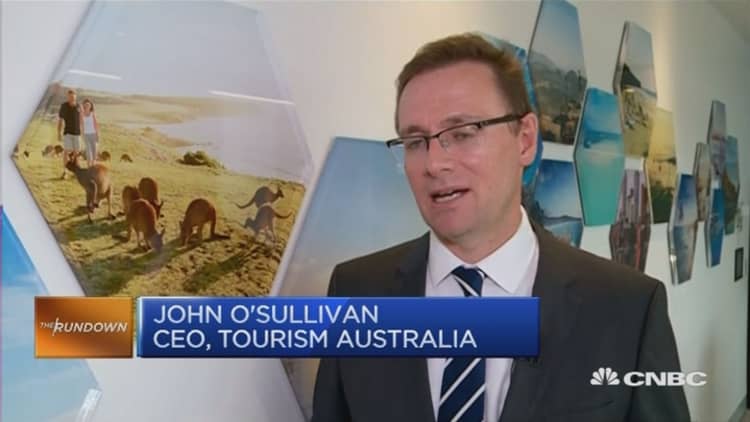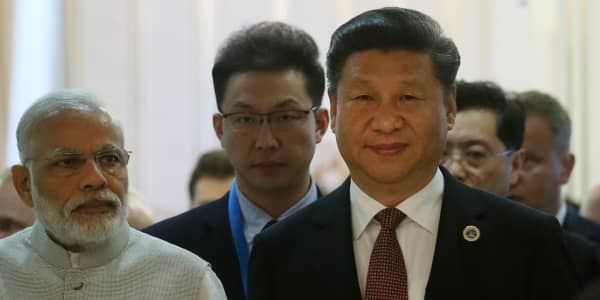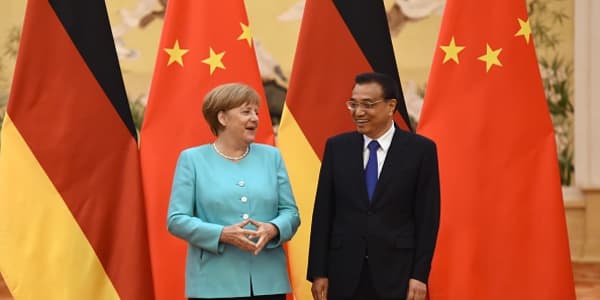Forget what you knew about Australia's relationship with China.
A shift by the world's second-largest economy from manufacturing to services-driven growth won't hurt resource-heavy Australia, even though it relies heavily on the Chinese mainland as a key market for its mining industry, experts told CNBC.
Paul Bloxham, chief economist for Australia and New Zealand at HSBC, told CNBC that as the Chinese economy shifted gear, Australia's connection to China was also changing.
"In tandem, while China's economic growth is shifting from investment to consumption, Australia at the same time is adjusting its economy, in terms of its exports, from resources more towards services," he said.
Resources still a key source of trade
Amid this ongoing transition in Australia's economy, the country continues to be a major resources producer, with much of its exports to the rest of the world made up of materials such as iron ore, coal, basic metals, liquefied natural gas and energy products.
For more than a decade, the biggest consumer of these exports has been China, in a relationship that served both countries' needs.
China has notched near or double-digit year-on-year growth in its gross domestic product for most of the last 20 years, fueled by a manufacturing boom that saw demand for raw materials and resources rise.
Australian resources, meanwhile, were key to meeting this demand, due to the availability of large volumes and relatively easy access to the Chinese mainland. In return, Australia served as a lucrative market for Chinese-made goods.
As a result, China became Australia's most important trading partner, both in terms of exports and imports - a position that is currently unchanged.
Data from the Australian Bureau of Statistics showed that between September 2015 and June 2016, the most recent period available, Australia exported 65.86 billion Australian dollars ($50.72 billion) worth of goods to China, and imported A$51.06 billion worth of goods from the mainland, a trade relationship larger than any Australia holds with other major markets.
Now, that manufacturing boom in China is petering outs and in recent years, the country's growth trajectory has taken a hit as policymakers in Beijing transition China a more services-driven economy.
But experts said China's shift to services economy would take time to materialize, which implied that resources such as iron ore would still remain a key Australian export to China for the foreseeable future.
Meanwhile, Chinese demand for other Australian exports, including agricultural products, food, beverages and wine, has been growing, according to James Laurenceson, deputy director at the Australia-China Relations Institute at the University of Technology, Sydney.
And Bloxham said that there was also growth in Australian services exports to China, including tourism, education and, increasingly, business services.
This broadening scope of trade will likely cushion the eventual slowdown of resources exports to the Chinese mainland.
Australia underlined the importance of its trade relationship with China by signing up to the China Australia Free Trade Agreement (ChAFTA), which came into effect on December 20, 2015, Laurenceson told CNBC, which meant the relationship would be preserved even though China is not party to the U.S.-led Trans-Pacific Partnership agreement, to which Australia is a signatory.
China a handy source of foreign capital
Alongside trade, Australia has benefited from a steady flow of Chinese investment in the country.
"A key reason why Australia didn't have a recession in the post Global Financial Crisis period was that we had a very strong mining investment boom," Bloxham said.
He noted that mining investment went from about 1.5 percent of the Australian economy to a peak of 8 percent in 2012, in part due to Chinese investment in resources assets, before falling in tandem with the economic slowdown in the mainland.
Investment bank Natixis explained in a recent report that Australia had the highest exposure in the region in terms of capital inflow from China in 2015. The report explained, "China has primarily invested in countries that are resource-rich or have superior technology."
However, the influx of Chinese capital into the country has raised some concerns. On Wednesday, Australian treasurer Scott Morrison blocked the sale of the country's biggest electricity network, Ausgrid, to foreign bidders. Short-listed bidders included the State Grid Corp of China.
Data from Dealogic showed that between 2012 and 2016, Chinese companies, mostly state-owned, made six times as many acquisitions in Australia than Australian companies did in China. China has spent $33.82 billion in acquisition in Australia between 2012 and 2016 year-to-date, compared to about $1.07 billion spent by Australian firms in China in the same period, the data showed.
China's total value of foreign direct investment in Australia, as compiled by the Department of Foreign Affairs and Trade, was worth A$74.9 billion in 2015, considerably lower than the A$860.3 billion invested by the U.S. and A$499.9 billion by the U.K.
Laurenceson said, however, that China's investment-led influence Down Under was set to grow as it looked to sectors outside resources, such as commercial and residential real estate, tourism and infrastructure to invest in.
No risk to Aussie sovereign debt
Meanwhile, China's slowdown will likely have a minimal impact on the Australian sovereign debt market because of the limited ownership of Australian Treasuries by China, Marie Diron, senior vice president for Sovereign Rating Group at Moody's, told CNBC.
As a result of the China's economic slowdown, as well as the weakening of the yuan by the People's Bank of China, the country has suffered large outflows from its foreign reserves for months, although they have slowed recently.
Reuters reported that China saw a total drop in reserves of around $513 billion in 2015, with $420 billion of that flowing out the final six months of the year.
Theoretically, if significant capital outflows resulted in the need for China to conduct vast sales of foreign exchange reserves, including Australian Treasuries, it could potentially disrupt Australia's sovereign debt market, according to Diron.
But she said data from the Australian Office of Financial Management (AOFM) showed North Asia, which includes China, Japan and South Korea, owned just 2.9 percent of Australian government securities as of June 2016.
A popular tourist destination
Tourism is also playing an increasingly important role in Australia's trade relations with China. Last year, China provided the second largest group of visitors to Australia - a group that spent more and stayed longer than all other groups of tourists, according to peak body Tourism Australia.
Those one million-plus Chinese visitors spent A$8.3 billion in 2015, and Tourism Australia estimates this number to grow to A$13 billion by 2020.

Tourism industry insiders told CNBC's Matthew Taylor earlier this year that Chinese tourists were becoming more ambitious and spending more on travel in Australia, which boded well for the sector.
"We are seeing more independent, more self-sufficient Chinese visitor come to Australia, more inquisitive, looking for self-drive experiences in particular," Tourism Australia CEO John O'Sullivan said.
Captain Cook Cruises, owned by Sealink, runs scenic boat tours of Sydney's iconic harbor. Andrew McEvoy, Sealink's chairman, said he had also noticed a promising change in the make-up of Chinese visitors.
"We're seeing many more premium Chinese travelers who want better experiences and are willing to pay more for it," he said.





